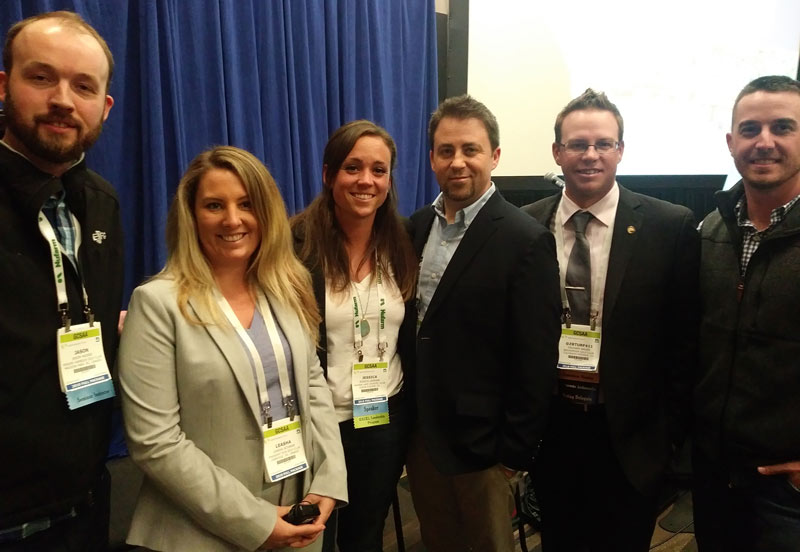
Some of the panel from the “Snap, Tweet and Post: Social Media in the Workplace” session at the Golf Industry Show (from left to right): Jason Haines, Leasha Schwab, Jessica Lenihan, Matt Dutkiewicz, Zach Bauer and Tony Bevolo. Photo by Howard Richman
Jessica Lenihan is doing her part to drive home the happenings of a golf course in Idaho — and social media is her vehicle for making that possible.
As the assistant superintendent at Hayden Lake Country Club in Couer d’Alene, Lenihan promotes the crew’s efforts not only in their corner of the world, but also on a universal stage. “It allows me to show what we have happening on a daily basis. It’s kind of putting our club on the map,” Lenihan says.
Lenihan was among a group that participated in the session “Snap, Tweet and Post: Social Media in the Workplace” on Tuesday at the Golf Industry Show. She was joined by moderator Zach Bauer, superintendent at Broadmoor Golf Club in Colorado Springs, Colo.; Tony Bevolo, account manager at Austin Turf and Tractor in Fort Worth, Texas; Leasha Schwab, superintendent at Pheasant Run Golf Club in Uxbridge, Ontario; Jason Haines, superintendent at Pender Harbour Golf Club in Madeira Park, British Columbia; Chris Tritabaugh, superintendent at Hazeltine National Golf Club in Chaska, Minn.; Matt Dutkiewicz, superintendent at Ingersoll Golf Course, Rockford, Ill.; and Claudia Alterman, GCSAA’s digital content specialist.
Communicating via Twitter isn’t something Tritabaugh, who hosted the 2016 Ryder Cup, takes for granted. Thinking twice before posting and taking the time to consider whether a post is appropriate is worthwhile. “With it comes a great deal of responsibility. If something inside says ‘This might not be quite right,’ it might be a good indication (not to post it),” he says.
Bevolo counts on Facebook to spread the word about a turfgrass equipment managers and technicians website — and it has grown, much to his delight. “We have had 94 new members in the last 28 days. That is significant,” says Bevolo, noting that the diversity of followers blows him away, with people in countries such as Germany, India and Malaysia participating. “What that means to me is they’re searching for solutions.”
Schwab emphasized the “extremely powerful” effect that social media possesses, which makes her careful about what she puts out there. “The impression that you can give someone might be quick, but it can last a long time,” Schwab says.
Haines, meanwhile, has quite a story. His nine-hole course was struggling until he turned to social media. Its boost has been extraordinary, he says. He has learned to take a minimalistic approach to overseeing the course, which has helped the prospects of the facility. “People on Twitter have been so generous with their knowledge. I learned we can make do with little and still have great conditions. It has been inspiring, really helped me find passion, and changed my attitude for what I was doing,” Haines says.
At his course, Dutkiewicz uses Snapchat to communicate with staff. “It’s the fastest and easiest way to get my message out. In my case, with really young people, it works really well for us,” Dutkiewicz says. “It can be as simple as a picture of something that needs to be fixed.”
Howard Richman is GCM’s associate editor.